Abstract
The enzymes of the Calvin reductive pentose phosphate cycle and the hexose monophosphate pathway have been demonstrated in cell-free extracts of Thiobacillus ferrooxidans. This, together with analyses of the products of CO2 fixation in cell-free systems, suggests that these pathways are operative in whole cells of this microorganism. Nevertheless, the amount of CO2 fixed in these cell-free systems was limited by the type and amount of compound added as substrate. The inability of cell extracts to regenerate pentose phosphates and to perpetuate the cyclic fixation of CO2 is partially attributable to low activity of triose phosphate dehydrogenase under the experimental conditions found to be optimal for the enzymes involved in the utilization of ribose-5-phosphate or ribulose-1,5-diphosphate as substrate for CO2 incorporation. With the exception of ribulose-1,5-diphosphate, all substrates required the addition of adenosine triphosphate (ATP) or adenosine diphosphate (ADP) for CO2 fixation. Under optimal conditions, with ribose-5-phosphate serving as substrate, each micromole of ATP added resulted in the fixation of 1.5 μmoles of CO2, whereas each micromole of ADP resulted in 0.5 μmole of CO2 fixed. These values reflect the activity of adenylate kinase in the extract preparations. The Km for ATP in the phosphoribulokinase reaction was 0.91 × 10−3m. Kinetic studies conducted with carboxydismutase showed Km values of 1.15 × 10−4m and 5 × 10−2m for ribulose-1,5-diphosphate and bicarbonate, respectively.
Full text
PDF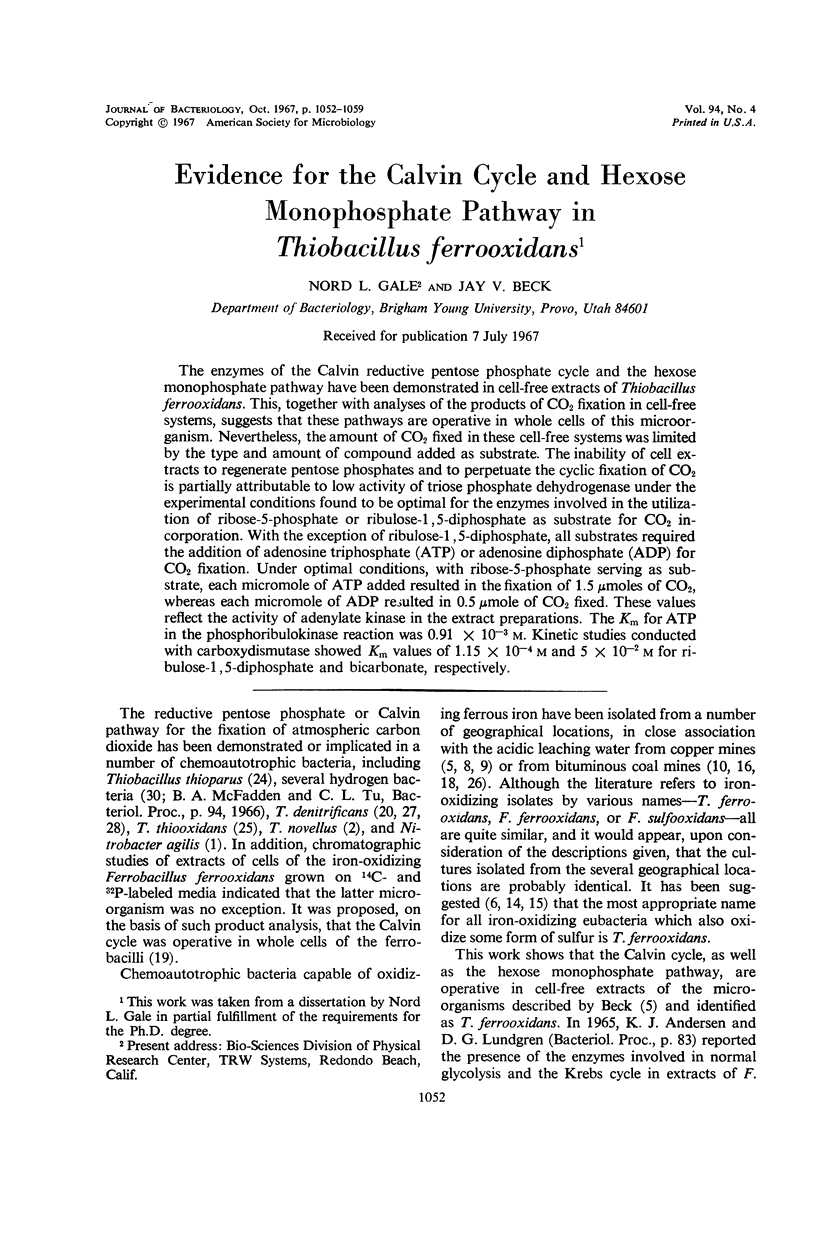
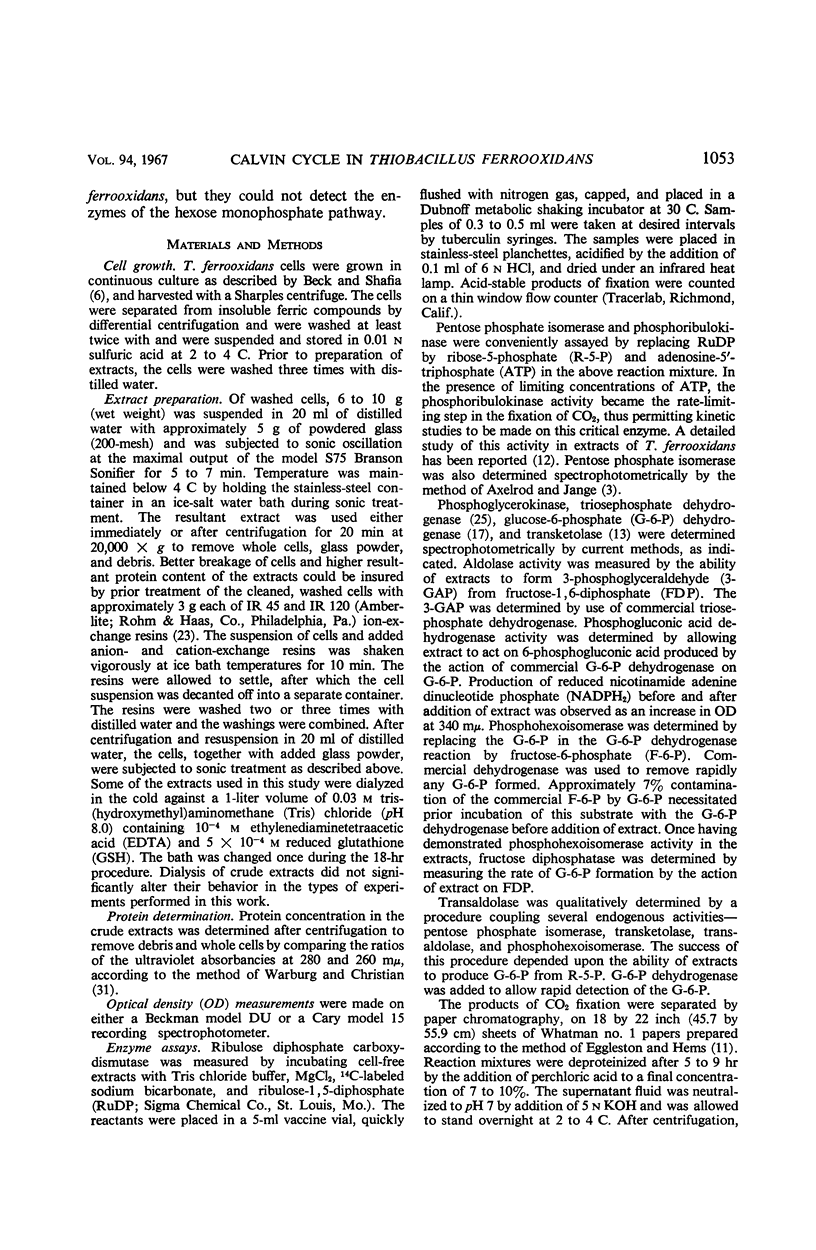


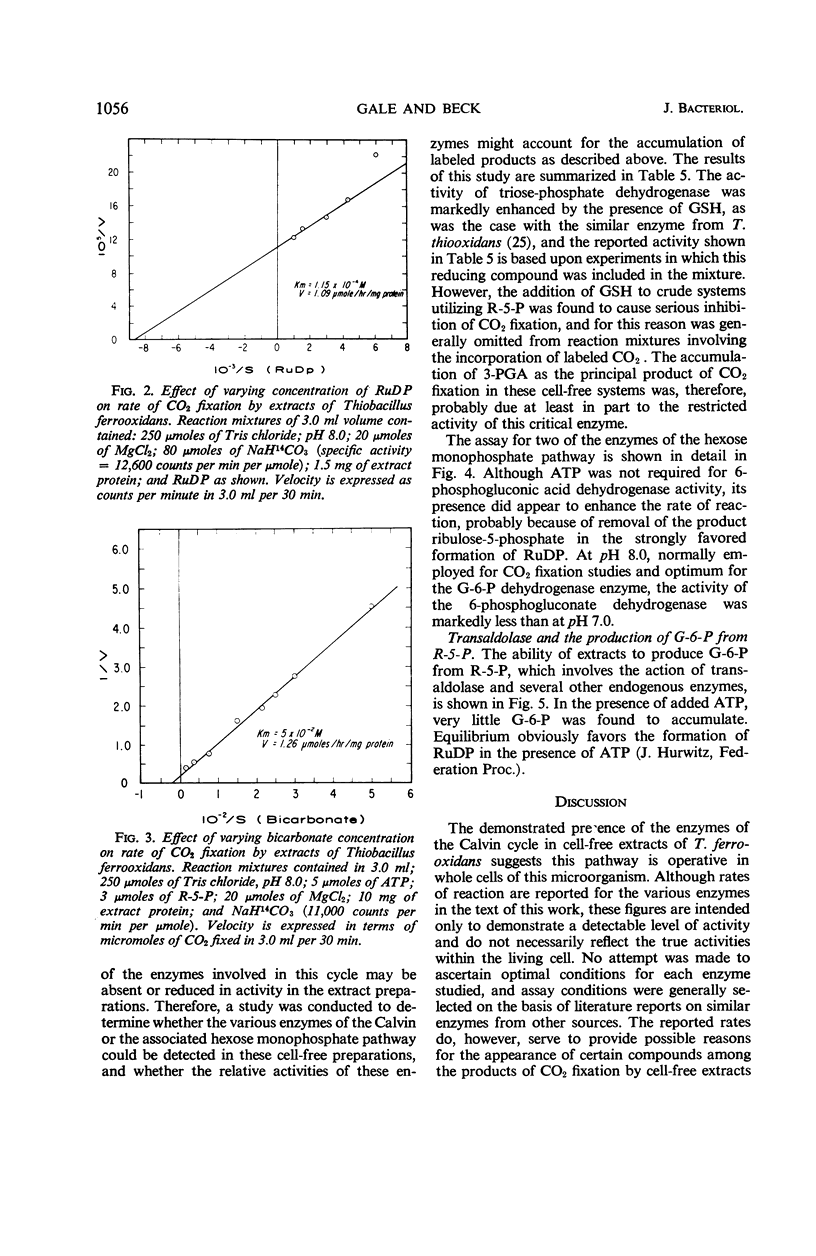

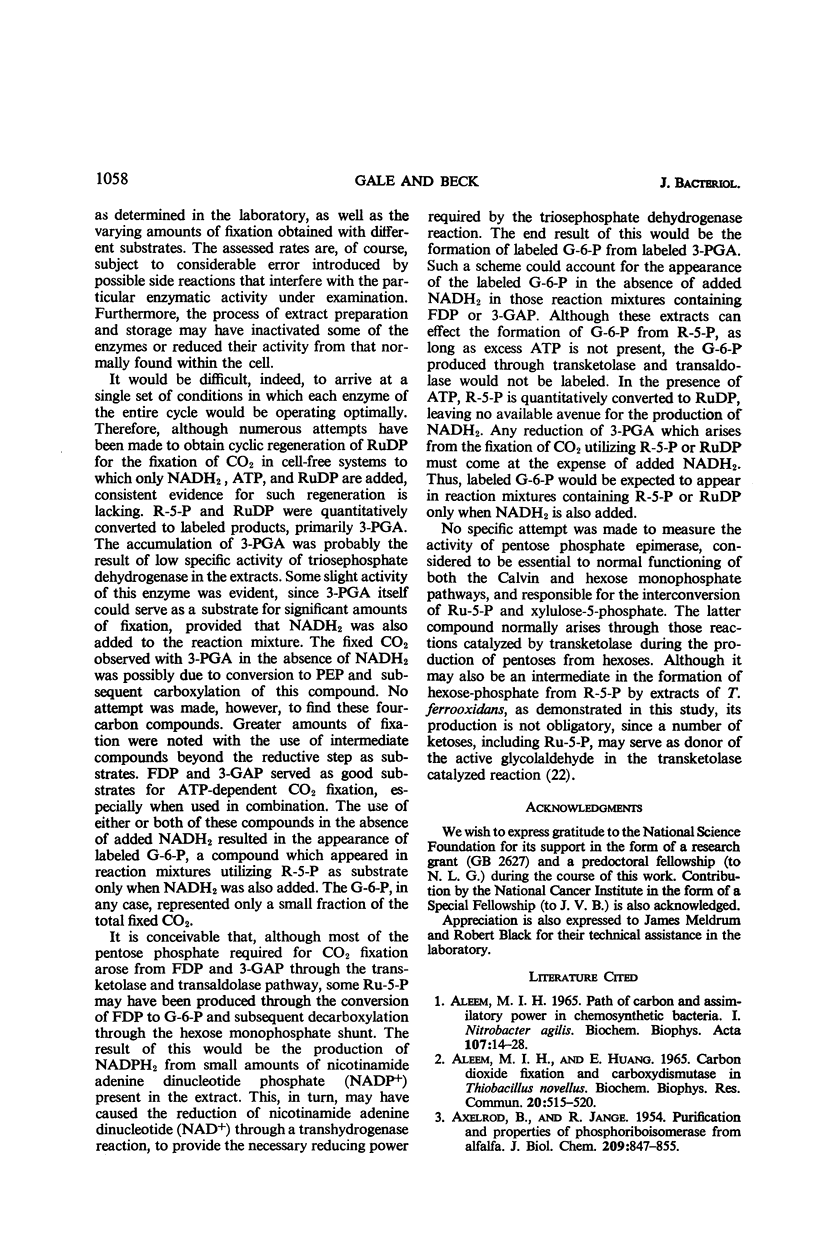
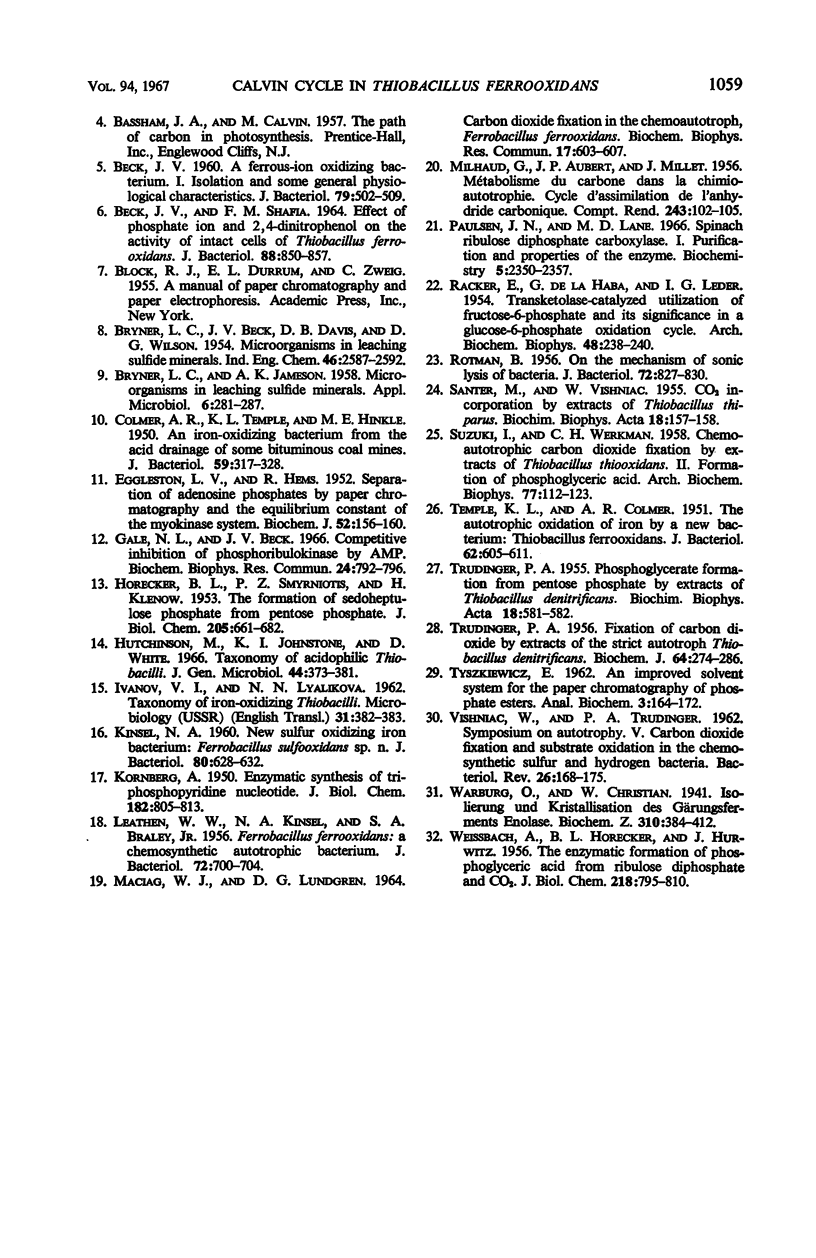
Selected References
These references are in PubMed. This may not be the complete list of references from this article.
- AXELROD B., JANG R. Purification and properties of phosphoribo-isomerase from alfalfa. J Biol Chem. 1954 Aug;209(2):847–855. [PubMed] [Google Scholar]
- Aleem M. I., Huang E. Carbon dioxide fixation and carboxydismutase in Thiobacillus novellus. Biochem Biophys Res Commun. 1965 Aug 16;20(4):515–520. doi: 10.1016/0006-291x(65)90610-8. [DOI] [PubMed] [Google Scholar]
- Aleem M. I. Path of carbon and assimilatory power in chemosynthetic bacteria. I. Nitrobacter agilis. Biochim Biophys Acta. 1965 Aug 24;107(1):14–28. doi: 10.1016/0304-4165(65)90384-3. [DOI] [PubMed] [Google Scholar]
- BECK J. V. A ferrous-ion-oxidizing bacterium. I. Isolation and some general physiological characteristics. J Bacteriol. 1960 Apr;79:502–509. doi: 10.1128/jb.79.4.502-509.1960. [DOI] [PMC free article] [PubMed] [Google Scholar]
- BECK J. V., SHAFIA F. M. EFFECT OF PHOSPHATE ION AND 2,4-DINITROPEHENOL ON THE ACTIVITY OF INTACT CELLS OF THIOBACILLUS FERROOXIDANS. J Bacteriol. 1964 Oct;88:850–857. doi: 10.1128/jb.88.4.850-857.1964. [DOI] [PMC free article] [PubMed] [Google Scholar]
- BRALEY S. A., Sr, KINSEL N. A., LEATHEN W. W. Ferrobacillus ferrooxidans: a chemosynthetic autotrophic Bacterium. J Bacteriol. 1956 Nov;72(5):700–704. doi: 10.1128/jb.72.5.700-704.1956. [DOI] [PMC free article] [PubMed] [Google Scholar]
- BRYNER L. C., JAMESON A. K. Microorganisms in leaching sulfide minerals. Appl Microbiol. 1958 Jul;6(4):281–287. doi: 10.1128/am.6.4.281-287.1958. [DOI] [PMC free article] [PubMed] [Google Scholar]
- COLMER A. R., TEMPLE K. L., HINKLE M. E. An iron-oxidizing bacterium from the acid drainage of some bituminous coal mines. J Bacteriol. 1950 Mar;59(3):317–328. doi: 10.1128/jb.59.3.317-328.1950. [DOI] [PMC free article] [PubMed] [Google Scholar]
- EGGLESTON L. V., HEMS R. Separation of adenosine phosphates by paper chromotography and the equilibrium constant of the myokinase system. Biochem J. 1952 Sep;52(1):156–160. doi: 10.1042/bj0520156. [DOI] [PMC free article] [PubMed] [Google Scholar]
- Gale N. L., Beck J. V. Competitive inhibition of phosphoribulokinase by AMP. Biochem Biophys Res Commun. 1966 Sep 8;24(5):792–796. doi: 10.1016/0006-291x(66)90396-2. [DOI] [PubMed] [Google Scholar]
- KINSEL N. A. New sulfur oxidizing iron bacterium: Ferrobacillus sulfooxidans sp. n. J Bacteriol. 1960 Nov;80:628–632. doi: 10.1128/jb.80.5.628-632.1960. [DOI] [PMC free article] [PubMed] [Google Scholar]
- MILHAUD G., AUBERT J. P., MILLET J. Métabolisme du carbone dans la chimioautotrophie; cycle d'assimilation de l'anhydride carbonique. C R Hebd Seances Acad Sci. 1956 Jul 2;243(1):102–105. [PubMed] [Google Scholar]
- Paulsen J. M., Lane M. D. Spinach ribulose diphosphate carboxylase. I. Purification and properties of the enzyme. Biochemistry. 1966 Jul;5(7):2350–2357. doi: 10.1021/bi00871a025. [DOI] [PubMed] [Google Scholar]
- RACKER E., DE LA HABA G., LEDER I. G. Transketolase-catalyzed utilization of fructose 6-phosphate and its significance in a glucose 6-phosphate oxidation cycle. Arch Biochem Biophys. 1954 Jan;48(1):238–240. doi: 10.1016/0003-9861(54)90331-8. [DOI] [PubMed] [Google Scholar]
- ROTMAN B. On the mechanism of sonic lysis of bacteria. J Bacteriol. 1956 Dec;72(6):827–830. doi: 10.1128/jb.72.6.827-830.1956. [DOI] [PMC free article] [PubMed] [Google Scholar]
- SANTER M., VISHNIAC W. CO2 incorporation by extracts of Thiobacillus thioparus. Biochim Biophys Acta. 1955 Sep;18(1):157–158. doi: 10.1016/0006-3002(55)90033-0. [DOI] [PubMed] [Google Scholar]
- TRUDINGER P. A. Fixation of carbon dioxide by extracts of the strict autotroph Thiobacillus denitrificans. Biochem J. 1956 Oct;64(2):274–286. doi: 10.1042/bj0640274. [DOI] [PMC free article] [PubMed] [Google Scholar]
- TRUDINGER P. A. Phosphoglycerate formation from pentose phosphate by extracts of Thiobacillus denitrificans. Biochim Biophys Acta. 1955 Dec;18(4):581–582. doi: 10.1016/0006-3002(55)90161-x. [DOI] [PubMed] [Google Scholar]
- TYSZKIEWICZ E. An improved solvent system for the paper chromatography of phosphate esters. Anal Biochem. 1962 Feb;3:164–166. doi: 10.1016/0003-2697(62)90107-0. [DOI] [PubMed] [Google Scholar]


